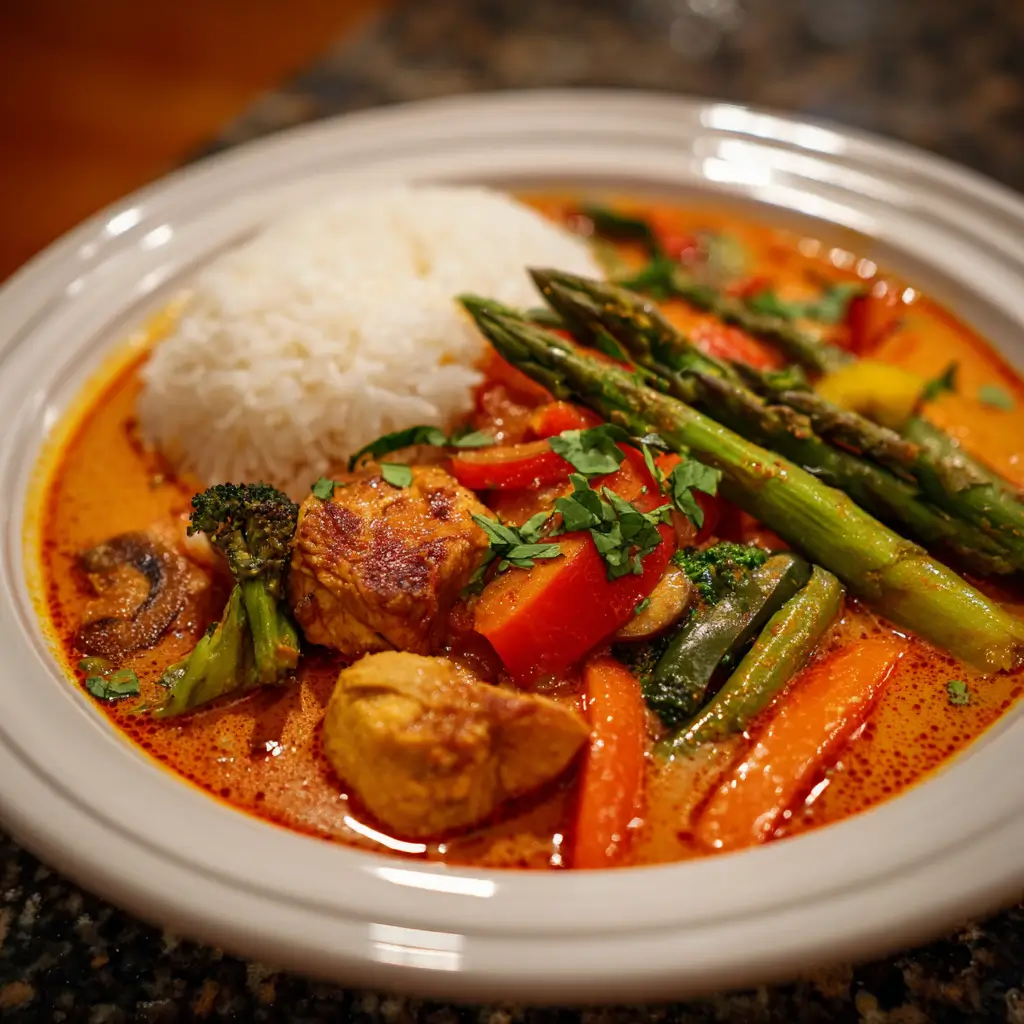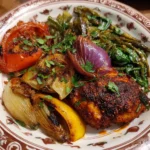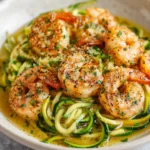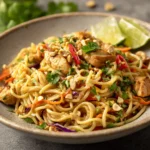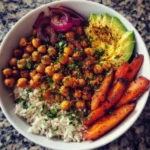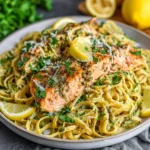Thai Red Curry Chicken with Veggies: A Flavorful Journey Through Tradition and Taste
The History of Thai Red Curry
Thai Red Curry, known in Thailand as Kaeng Phet, has deep roots in the rich culinary traditions of Southeast Asia. Originating from central Thailand, this vibrant dish evolved from ancient trade routes that brought Indian and Chinese influences into Thai cuisine. The use of curry pastes dates back centuries, with early versions made by pounding fresh herbs, chilies, and spices using a mortar and pestle. Red curry gets its name from the red chilies that form the base of the curry paste, distinguishing it from green or yellow curries.
Originally served in royal courts and later embraced by common households, Thai red curry was traditionally prepared with duck or pork. However, chicken became a popular protein due to its availability and mild flavor, which beautifully absorbs the complex layers of the spicy-sweet-savory sauce. Over time, regional variations emerged, incorporating local vegetables and seafood. Today, Thai Red Curry Chicken with Veggies is a staple not only in Thailand but around the world, beloved for its aromatic depth and comforting warmth.
Ingredients Breakdown: Understanding the Components
The magic of Thai Red Curry lies in its balance of ingredients—each playing a crucial role in creating harmony between heat, sweetness, saltiness, and umami. Let’s explore each component:
- Red Curry Paste: The soul of the dish. Traditionally made from dried red chilies, lemongrass, galangal, kaffir lime zest, garlic, shallots, shrimp paste, and coriander root. Store-bought versions are convenient, but homemade paste offers superior freshness and complexity.
- Chicken: Boneless, skinless thighs or breast work best. Thighs remain juicier during cooking, while breasts offer a leaner option.
- Coconut Milk: Full-fat coconut milk is essential for a creamy, luxurious texture. It tempers the spice and adds a subtle sweetness. Light coconut milk can be used, but it results in a thinner consistency.
- Vegetables: A colorful mix enhances both flavor and nutrition. Common choices include bell peppers (red, yellow, or green), bamboo shoots, zucchini, baby corn, and Thai eggplant. These add crunch, color, and absorb the curry’s essence.
- Fish Sauce: Provides savory depth and saltiness. A key umami booster in Thai cuisine. For vegetarians, soy sauce or tamari can substitute, though the flavor profile shifts slightly.
- Palm Sugar: Offers a caramel-like sweetness that balances the heat. Brown sugar is a suitable alternative if palm sugar isn’t available.
- Kaffir Lime Leaves: These fragrant leaves impart a citrusy aroma unique to Southeast Asian cooking. Torn before adding to release their oils.
- Basil: Fresh Thai basil (not sweet basil) adds a licorice-like note. Holy basil is traditional, but Thai basil is more accessible globally.
- Lime Juice: A splash at the end brightens the entire dish, cutting through the richness.
Step-by-Step Recipe
Follow these detailed steps to create an authentic and delicious Thai Red Curry Chicken with Veggies:
- Prepare Ingredients: Cut 1.5 lbs (700g) boneless chicken into bite-sized pieces. Slice 1 red bell pepper, 1 yellow bell pepper, 1 small zucchini, and drain ½ cup canned bamboo shoots. Mince 3 cloves garlic if making homemade paste, or have store-bought red curry paste ready (about 3–4 tbsp).
- Sauté the Curry Paste: In a large wok or heavy-bottomed pot, heat 1 tbsp vegetable oil over medium heat. Add 3–4 tablespoons of red curry paste and stir-fry for 1–2 minutes until fragrant. This step “blooms” the spices and intensifies flavor.
- Add Coconut Milk: Pour in 1 can (13.5 oz / 400ml) of full-fat coconut milk. Stir well, allowing the paste to fully dissolve into the milk. Simmer gently for 3–4 minutes until the oil begins to separate slightly—a sign of proper emulsification.
- Cook the Chicken: Add the chicken pieces to the simmering coconut mixture. Stir to coat evenly. Cook for 6–8 minutes, stirring occasionally, until the chicken is nearly cooked through.
- Add Vegetables: Introduce harder vegetables first (like bamboo shoots and bell peppers), followed by softer ones (zucchini, baby corn) after 2–3 minutes. This ensures even cooking without mushiness.
- Season the Curry: Stir in 1–2 teaspoons fish sauce (to taste), 1 tablespoon palm sugar (or brown sugar), and 3–4 torn kaffir lime leaves. Adjust seasoning gradually—you can always add more, but you can’t take it out.
- Simmer Until Tender: Continue cooking for another 8–10 minutes, allowing the vegetables to soften and the flavors to meld. Do not boil vigorously; gentle simmering preserves texture and aroma.
- Finish with Fresh Herbs: Turn off the heat. Stir in a generous handful of fresh Thai basil leaves and a squeeze of lime juice (about 1 tbsp). The residual heat will wilt the basil perfectly.
- Serve Immediately: Ladle the curry over steamed jasmine rice or sticky rice. Garnish with extra basil, a lime wedge, and thinly sliced red chili for heat lovers.
Tips for the Perfect Thai Red Curry
- Don’t Skip Blooming the Paste: Frying the curry paste in oil unlocks deeper flavors and removes any raw taste.
- Use Full-Fat Coconut Milk: Low-fat versions often contain stabilizers and lack the creamy mouthfeel needed for authentic texture.
- Control the Heat: Start with less curry paste and add more later. You can always increase spiciness, but cooling down an overly hot curry is tricky (though adding more coconut milk helps).
- Balance Sweet, Salty, Sour: Taste as you go. If too salty, add a touch more sugar. If too sweet, a splash of lime juice corrects it. Too sour? A pinch more sugar.
- Don’t Overcook Vegetables: Add them in stages based on density. Soft veggies like spinach should go in last, just to wilt.
- Rest Before Serving: Letting the curry sit for 5–10 minutes after cooking allows flavors to deepen further.
- Reheats Well: Flavors often improve the next day. Reheat gently on the stove with a splash of water or coconut milk to loosen.
Variations and Customizations
One of the joys of Thai Red Curry is its versatility. Here are some creative twists to personalize your dish:
- Protein Swaps: Replace chicken with shrimp, tofu, beef, duck, or even chickpeas for a vegan version.
- Vegetable Variations: Try broccoli, snow peas, mushrooms, carrots, or bok choy. Roasted squash adds a sweet contrast.
- Coconut-Free Option: For those avoiding coconut, use cashew cream or blended silken tofu as a base, though the flavor will differ.
- Spice Level Adjustments: Mild? Use only 1–2 tsp of paste. Fiery? Add fresh red chilies or a dash of chili oil at the end.
- Gluten-Free Version: Ensure your fish sauce is gluten-free (many brands are), or substitute with tamari.
- Herb Twists: Experiment with cilantro, mint, or culantro for different aromatic profiles.
- Curry Fusion: Add a spoonful of peanut butter for a Thai-Indonesian fusion, or top with crushed peanuts for texture.
- Noodle Curry: Serve over rice noodles instead of rice for a heartier meal resembling a curry ramen.
Health Considerations and Nutritional Value
Thai Red Curry Chicken with Veggies is not only delicious but also packed with nutrients when prepared thoughtfully.
Nutritional Highlights:
- High-Quality Protein: Chicken provides lean protein essential for muscle repair and satiety.
- Healthy Fats: Coconut milk contains medium-chain triglycerides (MCTs), which may support metabolism. However, it’s high in saturated fat, so moderation is key, especially for heart health.
- Fiber-Rich Vegetables: Bell peppers, zucchini, and bamboo shoots contribute dietary fiber, aiding digestion and blood sugar control.
- Antioxidants & Phytonutrients: Red chilies contain capsaicin, known for anti-inflammatory properties. Lemongrass and galangal offer antimicrobial benefits.
- Vitamins and Minerals: Rich in vitamin C (from peppers and lime), vitamin A (from red chilies), potassium, and iron.
Health Tips:
- To reduce sodium, use low-sodium fish sauce or dilute regular fish sauce with water.
- For lower fat content, skim excess coconut cream from the top of the can before using, or use light coconut milk (though flavor suffers).
- Beware of store-bought curry pastes—they often contain added sugar, salt, and preservatives. Check labels or make your own.
- Serve with cauliflower rice or quinoa for a lower-carb alternative.
- Portion control matters—while nutritious, this dish can be calorie-dense due to coconut milk.
Ingredients
- 3–4 tablespoons Thai red curry paste (store-bought or homemade)
- 1 tablespoon vegetable oil (coconut, sunflower, or canola)
- 1 can (13.5 oz / 400ml) full-fat coconut milk
- 1.5 lbs (700g) boneless, skinless chicken thighs or breasts, cut into 1-inch cubes
- 1 red bell pepper, sliced
- 1 yellow bell pepper, sliced
- 1 small zucchini, halved and sliced
- ½ cup canned bamboo shoots, drained
- 3–4 kaffir lime leaves, torn (or 1 tsp lime zest as substitute)
- 1–2 teaspoons fish sauce (adjust to taste)
- 1 tablespoon palm sugar (or brown sugar)
- 1 cup fresh Thai basil leaves
- 1 tablespoon fresh lime juice
- Jasmine rice or sticky rice, for serving
- Optional garnishes: sliced red chili, lime wedges, chopped cilantro, fried shallots
Directions
- Heat oil in a large wok or deep skillet over medium heat. Add red curry paste and sauté for 1–2 minutes until aromatic.
- Pour in about half the can of coconut milk (the thick cream from the top). Stir continuously for 3–4 minutes until the mixture bubbles and the oil starts to rise to the surface.
- Add the chicken pieces and cook for 6–8 minutes, stirring occasionally, until the outside is opaque.
- Stir in the remaining coconut milk and enough water (about ½ cup) to achieve desired thickness. Bring to a gentle simmer.
- Add bell peppers and bamboo shoots. Simmer for 5 minutes.
- Add zucchini and continue cooking for another 5–7 minutes until vegetables are tender-crisp and chicken is fully cooked.
- Season with fish sauce, palm sugar, and torn kaffir lime leaves. Stir well and taste. Adjust seasoning as needed.
- Turn off the heat. Stir in Thai basil and lime juice.
- Serve hot over steamed jasmine rice, garnished with additional herbs and lime wedges.
FAQ
Can I make Thai Red Curry vegetarian?
Yes! Substitute chicken with tofu, tempeh, or chickpeas, and replace fish sauce with soy sauce or a vegan fish sauce alternative.
How long does it keep in the fridge?
Properly stored in an airtight container, it lasts 3–4 days. Flavors often deepen overnight.
Can I freeze Thai Red Curry?
Yes, it freezes well for up to 3 months. Thaw in the refrigerator and reheat gently on the stove. Stir in fresh basil and lime juice after reheating.
Why did my coconut milk split?
This is normal and actually desirable! When the oil separates, it indicates the curry paste is properly infused. Just stir it back in.
What’s the difference between red, green, and yellow curry?
Red uses dried red chilies (spicier, earthy), green uses fresh green chilies (bright, herbal), and yellow includes turmeric (milder, slightly sweet).
Can I use frozen vegetables?
Yes, but add them toward the end to prevent overcooking. Blanch dense veggies like carrots first.
Is Thai red curry gluten-free?
Typically yes, but check curry paste and fish sauce labels—some brands contain wheat. Tamari is a safe alternative.
Summary
Thai Red Curry Chicken with Veggies is a vibrant, aromatic dish that blends spicy, sweet, and savory flavors with tender chicken and crisp vegetables in a creamy coconut broth. Easy to customize and rich in cultural heritage, it’s a nourishing meal that brings the taste of Thailand to your kitchen.
